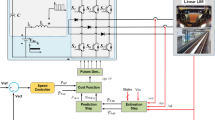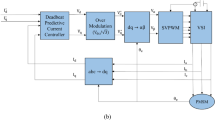Abstract
In renewable energy-sourced power systems, asynchronous motors serve as elements that both produce and consume electricity. The stability and efficiency of the asynchronous motor in renewable energy system should be considered. Although performance optimization studies have been carried out using power circuits that control the asynchronous motor fed with solar energy and control units such as proportional, integral, derivation (PID), and Fuzzy logic; They may be insufficient to eliminate and reduce vibrations in the output values of an induction motor fed with a renewable energy source. Losses occur as the system performance decreases constantly due to oscillations. In this study, an induction motor power system is optimized with the extra control coefficient (ECCA)-PID, which provides semi-linear control for the first time, unlike the power systems controlled by other linear controllers used so far to reduce oscillations, and the vibration losses are eliminated. The speed oscillations, torque oscillations, and oscillation losses of the induction motor in the system are controlled by conventional PID, and Fuzzy logic controllers in order to demonstrate the effectiveness of the proposed method in simulation and experimentation. Then, the results are compared after the proposed method are examined. As a result of the comparisons, while the motor oscillations and losses in the power system continue throughout the control period in traditional control methods, the proposed method reduces the losses to zero in a large part of the control period.




















Similar content being viewed by others
Availability of data and materials
The original contributions presented in the study are included in the article/Supplementary Material, further inquiries can be directed to the corresponding author.
References
Deepak M, Janaki G and Bharatiraja C 2023 Performance Analysis on Induction Motor Integrated Wide Band Gap Bidirectional Converter for Low Power Traction Applications. In: 2023 Second International Conference on Electrical, Electronics, Information and Communication Technologies 59(4): 1-6
Hannan M A, Abd Ali J, Ker P J, Mohamed A, Lipu M S and Hussain A 2018 Switching techniques and intelligent controllers for induction motor drive: issues and recommendations. IEEE Access 6: 47489–47510
Li M, Virguez E, Shan R, Tian J, Gao S and Patiño-Echeverri D 2022 High-resolution data shows China’s wind and solar energy resources are enough to support a 2050 decarbonized electricity system. Appl. Energy 306: 117996
Sarac V, Stefanov G and Minovski D 2021 Speed regulation of induction motor with PWM inverter. Etima 1(1): 30–41
Hilarydoss S 2023 Suitability, sizing, economics, environmental impacts and limitations of solar photovoltaic water pumping system for groundwater irrigation—a brief review. Environ. Sci. Pollut. Res. 30(28): 71491–71510
Bouyahia O, Betin F and Yazidi A 2022 Fault tolerant variable structure control of six-phase induction generator for wind turbines. IEEE Trans. Energy Convers. 37(3): 1579–1588
Aljafari B, Pamela Stephenraj J, Vairavasundaram I and Singh Rassiah R 2022 Steady state modeling and performance analysis of a wind turbine-based doubly fed induction generator system with rotor control. Energies 15(9): 3327
Quispe J C and Orduña E 2022 Transmission line protection challenges influenced by inverter-based resources: a review. Prot. Control Mod. Power Syst. 7(1): 1–17
Taras P, Nilifard R, Zhu Z Q and Azar Z 2022 Cooling techniques in direct-drive generators for wind power application. Energies 15(16): 5986
Kalla U K, Bhati N, Chariya K and Qureshi I 2021 Design and Analysis of Solar PV Fed IMD Water-Pumping System. In: 2021 International Conference on Sustainable Energy and Future Electric Transportation 22(4): 1-6
Rachaputi B P, Rathinadurai Louis J and Sridharan M 2023 Solar photovoltaic array fed single-stage sensorless vector control of induction motor drive for water pumping applications. Int. J. Energy Environ. Eng. 14(4): 643–660
Hamdi T, Elleuch K, Abid H and Toumi A 2023 Sliding mode controller with fuzzy supervisor for MPPT of photovoltaic pumping system. Int. J. Power Electron. Drive Syst. 14(3): 1639–1650
Chhipą A A, Chakrabarti P, Bolshev V, Chakrabarti T, Samarin G, Vasilyev A N and Kudryavtsev A 2022 Modeling and control strategy of wind energy conversion system with grid-connected doubly-fed induction generator. Energies 15(18): 6694
Mei J, Zuo Y, Lee C H T and Kirtley J L 2020 Modeling and optimizing method for axial flux induction motor of electric vehicles”. IEEE Trans. Veh. Technol. 69(11): 12822–12831
Wang Y, Tian L, Zhang L and Zhao H 2021 Auto-tracking frequency regulation-based energy saving technology for motor systems with dynamic and potential energy load. IEEE Access 9: 131806–131814
Li G, Fu Z and Wang Y 2021 Electromagnetic vibration and noise suppression of induction motor based on RPWM selective spectrum shaping. IEEE Access 9: 54509–54517
Tran D T, Hoang N M, Loc N H, Truong Q T and Nha N T 2023 A fuzzy LQR PID control for a two-legged wheel robot with uncertainties and variant height. J. Robot. Control 4(5): 612–620
Chen D, Qian L, Zou Q, Yin Q and Yue C 2022 An improved quasi-continuous controller with disturbance observer for rotational shell magazine position control. Int. J. Control Autom. Syst. 20(10): 3198–3212
Ferdiansyah I, Raharja L P S, Yanaratri D S and Purwanto E 2019 Design of PID controllers for speed control of three phase induction motor based on direct-axis current (Id) coordinate using IFOC. In: 2019 4th International Conference on Information Technology, Information Systems and Electrical Engineering (ICITISEE), 21: 369-372
Rao M A, Basha S M, Kumar M V and Sai C P 2019 Implementation of fuzzy based on second order sliding mode controller fed induction motor drive for disturbance rejection analysis. In: 2019 3rd International Conference on Recent Developments in Control, Automation & Power Engineering (RDCAPE), 448-454
Sengupta A and Das D K 2022 Delay dependent wide area damping controller design for a linear parameter varying (LPV) power system model considering actuator saturation and changing environmental condition. Sādhanā 47(2): 1–14
Deepika D and Singh N 2022 Exponential state observer based finite time control of fully active hybrid energy storage system. Sādhanā 47(1): 1–11
Khan M A, Haque A, Kurukuru V S B and Blaabjerg F 2023 Optimizing the performance of single-phase photovoltaic ınverter using wavelet-fuzzy controller. e-Prime-Adv. Electr. Eng. Electron. Energy 3: 100093
García-Triviño P, Sarrias-Mena R, García-Vázquez CA, Leva S and Fernández-Ramírez LM 2023 Optimal online battery power control of grid-connected energy-stored quasi-impedance source inverter with PV system. Appl. Energy 13(5): 329, 120286
Long B, Li X, Rodriguez J, Guerrero J M and Chong K T 2023 Frequency stability enhancement of an islanded microgrid: a fractional-order virtual synchronous generator. Int. J. Electr. Power Energy Syst. 147: 108896
Gouaamar R, Bri S and Mekrini Z 2024 Improvements the direct torque control performance for an induction machine using fuzzy logic controller. Int. J. Electr. Comput. Eng. 14(1): 1–11
Tseligorov N A, Chubukin A V, Naser A K, Olkhovatov D V and Tseligorova E N 2021 Modeling of the tunnel kiln control system taking into account the features of the pid controller and fuzzy logic. J. Phys Conf. Ser. 2131:2, 022022
Abdallah A and Hasan T F 2022 Optimization of energy efficiency of three phase induction motor drives for industrial applications. Asian J. Electr. Electron. Eng. 2(1): 32–39
Saleem A, Soliman H, Al-Ratrout S and Mesbah M 2018 Design of a fractional order PID controller with application to an induction motor drive. Turk. J.Electr. Eng. Comput. Sci. 26(5): 2768–2778
Jasim Q K and Ali M M E 2023 Design of suspension control system for bearingless induction motor using self tuning fuzzy-PID controller. Przeglad Elektrotech. 99: 3
Li C, Xu S and Zhang W 2022 Research on Asynchronous Motor Vector Control System with Fuzzy Slide Mode Speed Regulator. In: 2022 IEEE 6th Information Technology and Mechatronics Engineering Conference (ITOEC) 6, 984-988
Farbood M, Shasadeghi M, Izadian A and Niknam T 2022 Fuzzy model predictive MPPT control of interconnected wind turbines drivetrain. Asian J. Control 24(5): 2714–2727
Mahfoud S, Derouich A, El Ouanjli N, El Mahfoud M and Taoussi M 2021A new strategy-based PID controller optimized by genetic algorithm for DTC of the doubly fed induction motor. Systems 9(2): 37
Author information
Authors and Affiliations
Corresponding author
Ethics declarations
Conflict interest
There is no conflict interest for the article.
Rights and permissions
Springer Nature or its licensor (e.g. a society or other partner) holds exclusive rights to this article under a publishing agreement with the author(s) or other rightsholder(s); author self-archiving of the accepted manuscript version of this article is solely governed by the terms of such publishing agreement and applicable law.
About this article
Cite this article
CAN, E. Torques and the speed vibrations reducing and optimization of asynchronous motor with ECCA-PID controlling in power system. Sādhanā 49, 126 (2024). https://doi.org/10.1007/s12046-024-02491-2
Received:
Revised:
Accepted:
Published:
DOI: https://doi.org/10.1007/s12046-024-02491-2




